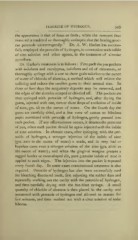Page 507 - My FlipBook
P. 507
PEROXIDE OF HYDROGEN. 505
the appearance is that of foam or froth ; while the remnant thus
removed is rendered so thoroughly antiseptic that the healing proc-
ess proceeds uninterruptedly." Dr. A. W. Harlan has success-
fully employed the peroxide of hydrogen, in connection with iodide
of zinc solution and other agents, in the treatment of alveolar
pyorrhoea.
Dr. Harlan's treatment is as follows : First pack the pus pockets
with iodoform and eucalyptus, iodoform and oil of cinnamon, or
thoroughly syringe with a one to three grain solution to the ounce
of water of chloride of alumina, a method which will relieve the
suffering and reduce the swollen gums to their normal size. In
three or four days the sanguinary deposits may be removed, and
the edges of the alveolus scraped or chiseled off. The pockets are
then syringed with peroxide of hydrogen, and, after drying the
gums, injected with one, two or three drops of a solution of iodide
of zinc, grs. xii to the ounce of water. On the fourth day the
gums are carefully dried, and a fine cone of cotton or bibulous
paper moistened with peroxide of hydrogen, gently pressed into
each pocket. If any effervescence occurs, it denotes the presence
of pus, when each pocket should be again injected with the iodide
of zinc solution. In chronic cases, after syringing with the per-
oxide of hydrogen, a stronger injection of the iodide of zinc
(grs. xxiv to the ounce of water) is made, and in very bad or
hopeless cases even a stronger solution of the zinc (grs. xlviii to
the ounce of water) ; and when the gingiyal margins present a
ragged border or cone-shaped slit, pure granular iodide of zinc is
applied to such edges. The injection into the pocket is repeated
every fourth day. In some cases constitutional treatment is also
required. Peroxide of hydrogen has also been successfully used
for bleaching discolored teeth, first adjusting the rubber dam and
repeatedly washing out the cavity with the peroxide of hydrogen,
and then carefully drying with the hot-blast syringe. A small
quantity of chloride of alumina is then placed in the cavity and
moistened with peroxide of hydrogen and allowed to remain for
five minutes, and then washed out with a clear solution of sodze
biboras.


